


![]()

| Home | Officers | Diary | Towers | Training | Services | Newsletters | Documents | Events | History | Links |
 A first for Hurst
A first for HurstFor the first time in its history, on the weekend of 25-26 June 2016, the Hurst Show was host to the Charmborough Ring , a portable belfry with 6 bells hung for full circle ringing. It was hired and run by ringers from the surrounding area.
The Ring is a scaled down version of the type of bells that hang in over 6,000 towers where English style ringing is practised, but unlike most towers, where the bells and ringers are hidden away, with the Charmborough Ring both the bells and the ringers are fully visible, making it easy to see how the ringers control the bells.
The Charmborough Ring has visited over 100 venues in the decade since it was built, allowing tens of thousands of non-ringing members of the public to see and hear ringing at first hand.
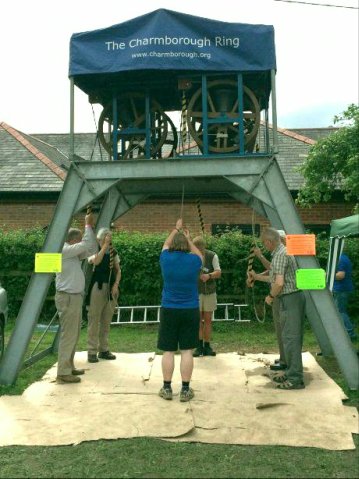 A unique experience
A unique experienceBellringing is a fascinating activity that engages the mind as well as the body. It evolved in England around 400 years ago and has since spread to other parts of the (mainly English speaking) world. It continues to develop as modern ringers achieve performances that previous generations would not have dreamt of. At the Show, a couple of thousand people were able to see and hear ringing in a way that is not normally possible.
The bells were in use throughout the whole of the show, from 10am to 5pm on the Saturday and Sunday. During this time teams of experienced ringers gave short demonstrations of how the bells are rung. (The cardboard on the ground was to prevent it turning to mud after a heavy downpour!)
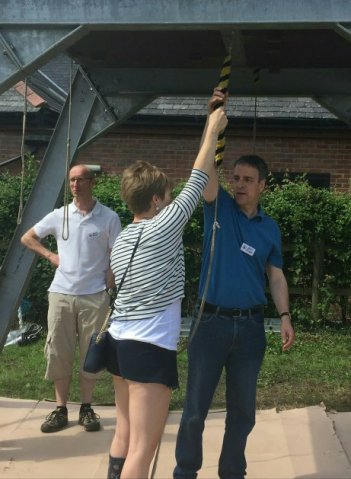
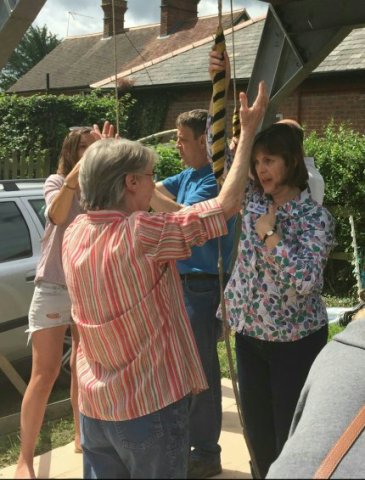 Between ringing demonstrations members of the public were able to ask questions and try their hand at ringing, under the guidance of experienced ringers.
Between ringing demonstrations members of the public were able to ask questions and try their hand at ringing, under the guidance of experienced ringers.
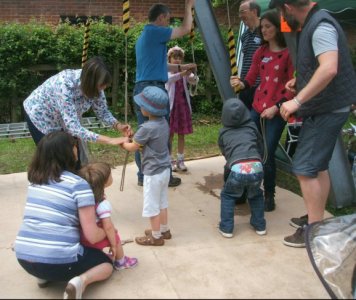 Adults and older children had a serious try at full-circle ringing while young children had a field day swinging the bells to make as much noise as possible.
Adults and older children had a serious try at full-circle ringing while young children had a field day swinging the bells to make as much noise as possible.
During the weeks following the show, the couple of dozen people whose interest in ringing had been sparked by their experience there were invited to a series of special taster sessions on full size bells at Twyford. These intensive sessions enabled them to get a much better feel for what real ringing is like so they could decide whether to go on and develop their skills as ringers with local bands. The sessions lasted two hours and as well as a period of one-to-one hands-on instruction the participants had the opportunity to learn more about change ringing and other aspects of life as a ringer.
The 'tower' and bells had to be erected and dismantled at the start and end of show. The total weight is over a ton and a half, but the structure is designed for portability. It took us about an hour and a half to erect at the start of the show and another hour at the end to dismantle it.
Everything comes to site in a heavy-duty trailer. The main frame members are bolted together on the ground and then raised into position ( a five person lift) to form the 'tower'. Once the 'tower' is up, the bells are lifted into position and secured. Each pair, complete with its wheels and fittings, is in a sub-frame to make this easier. Finally the canvas 'roof' is fitted and the trailer removed so the ringers can take their places beneath the bells to ring them.
Although the bells are much smaller than normal tower bells they work in the same way, swinging full circle, from mouth-up to mouth-up and back again, with the ringers controlling them from below with ropes that wrap alternately each way round the bell wheels, so the action of ringing them is similar to ringing full size tower bells.
Erecting the Ring at Hurst – Click to see larger images
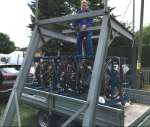 Main frame erected |
 Adding the upper frame for the hoist |
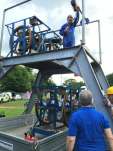 Preparing to raise the last pair of bells |
 All bells in situ - clearing away |
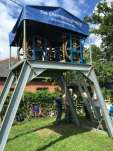 Complete and ready for action |
Did you know – Because of the special way that bells are hung, a skilled ringer can control the timing at which a tower bell sounds to a precision of a few hundredths of a second – even though the bell may weigh half a ton, or much more than a ton!
| Back to Home Page | Back to Top |
| Page updated on |
|
© Oxford Diocesan Guild of Church Bell Ringers (Sonning Deanery Branch) 2010 | |